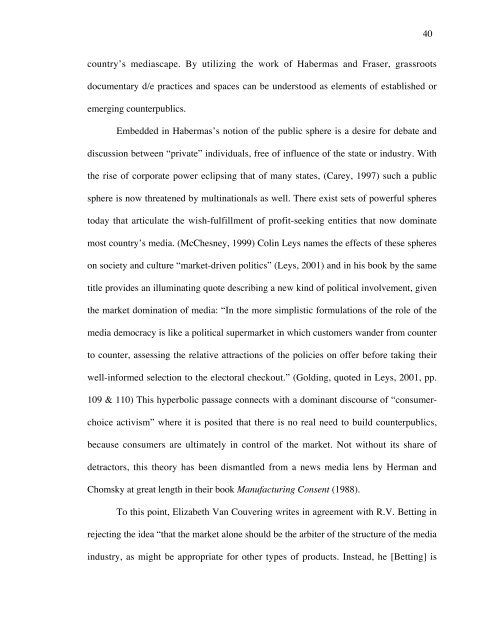The Spaces Between Grassroots Documentary ... - Ezra Winton
The Spaces Between Grassroots Documentary ... - Ezra Winton
The Spaces Between Grassroots Documentary ... - Ezra Winton
You also want an ePaper? Increase the reach of your titles
YUMPU automatically turns print PDFs into web optimized ePapers that Google loves.
country’s mediascape. By utilizing the work of Habermas and Fraser, grassroots<br />
documentary d/e practices and spaces can be understood as elements of established or<br />
emerging counterpublics.<br />
Embedded in Habermas’s notion of the public sphere is a desire for debate and<br />
discussion between “private” individuals, free of influence of the state or industry. With<br />
the rise of corporate power eclipsing that of many states, (Carey, 1997) such a public<br />
sphere is now threatened by multinationals as well. <strong>The</strong>re exist sets of powerful spheres<br />
today that articulate the wish-fulfillment of profit-seeking entities that now dominate<br />
most country’s media. (McChesney, 1999) Colin Leys names the effects of these spheres<br />
on society and culture “market-driven politics” (Leys, 2001) and in his book by the same<br />
title provides an illuminating quote describing a new kind of political involvement, given<br />
the market domination of media: “In the more simplistic formulations of the role of the<br />
media democracy is like a political supermarket in which customers wander from counter<br />
to counter, assessing the relative attractions of the policies on offer before taking their<br />
well-informed selection to the electoral checkout.” (Golding, quoted in Leys, 2001, pp.<br />
109 & 110) This hyperbolic passage connects with a dominant discourse of “consumer-<br />
choice activism” where it is posited that there is no real need to build counterpublics,<br />
because consumers are ultimately in control of the market. Not without its share of<br />
detractors, this theory has been dismantled from a news media lens by Herman and<br />
Chomsky at great length in their book Manufacturing Consent (1988).<br />
To this point, Elizabeth Van Couvering writes in agreement with R.V. Betting in<br />
rejecting the idea “that the market alone should be the arbiter of the structure of the media<br />
industry, as might be appropriate for other types of products. Instead, he [Betting] is<br />
40


